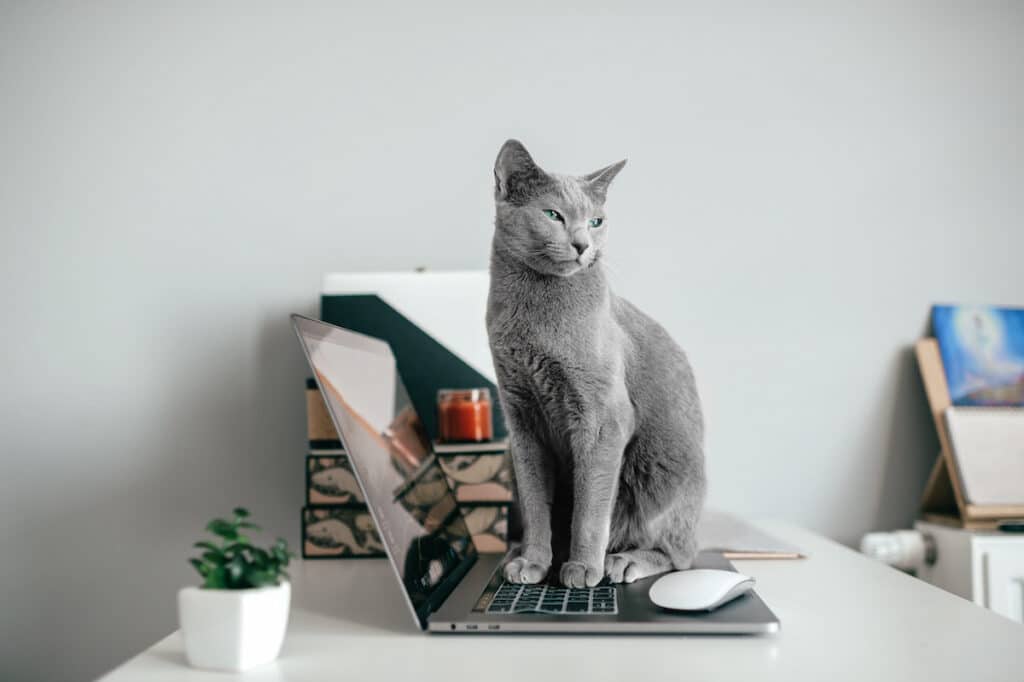How To Stop Your Cat From Jumping on the Computer
Cats who are curious often find keyboard activity to be alluring. As soon as you begin typing, your cat will rush to where your hands are moving on the keyboard. The outcomes can include sending emails before you’re ready, typing incoherently in messages or documents, or—worst of all—erasure by paw pressure! For these reasons you’ll probably want to stop your cat from jumping on the computer.
It takes attentiveness and quick thinking on your part, some preventative measures, and paying attention to some commonsense habits when you’re not at your workstation to deter your cat from keyboard antics.
Block off Your Computer to Stop Your Cat From Jumping on it
Do not leave your cat unattended around your keyboard. Put the keyboard out of reach whenever you need to step away from your computer terminal, regardless of the duration or reason. Your cat won’t be able to pad across the keys and leave nonsense for your email friends should it become curious and investigate. Make it a habit to regularly put the keyboard away so that you do it whenever you leave the desk.
Watch your cat and stop them from jumping on the keyboard. Keep an eye out for the cat’s interest in the keyboard so you can see whether it’s getting ready to pounce. If the cat moves swiftly, you will have the chance to move the keyboard. If the cat seems to be lurking too close, another choice is to move the cat. You might also take advantage of this occasion to speak in an authoritative manner by saying: “No! You won’t be perched on my keyboard.”
Block the cat from getting into the keyboard area. Consider building a barrier to keep your cat from entering your work area or from getting to the keyboard area. A barricade’s goal is to create a barrier that the cat perceives as being unwarrantedly difficult. The usefulness or viability of doing this entirely depends on the type of workspace you have and the way you operate.
A barrier can also be used to block the cat’s view of the keyboard and your finger movements, eliminating the stimulus for further research. For instance, you may set up book stacks on either side of your keyboard space. If you have a lot of desk space, this might be a good idea.
Shut the door to your room to keep your cat out. Blocking your cat’s access to the space where you are working is a particularly effective approach to stop them from jumping on the computer. Naturally, this is based on where your computer is. It won’t be possible to accomplish this in an open area. Consider the ultimate barrier of closing the door on the other side if you have a distinct study and a door that can be closed. This approach, nevertheless, might make your cat unhappy. To try to get inside, it could meow or scratch at the door.
Put your cat in its own room for a limited amount of time. If you need to work uninterrupted and your cat needs its own space, try doing that. Put your cat’s bed, food, drink, litter box, and toys, for instance, in the restroom for about an hour. When the work is finished, go outside and spend some quality time with each other.
You shouldn’t always keep your cat inside a sealed room by himself. While temporarily containing it won’t do any harm, this should not be a permanent solution. Getting imprisoned inside a cat carrier or crate, facing you, can temporarily function as a solution for really energetic cats who don’t get the message. Depending on how much meowing occurs after shutting it away, this will either be a success or a failure. Make sure the cat can see you and appears at ease, though.
Discourage your Cat from Jumping on the Computer
Use a computer stand to stop yur cat from jumping on the computer. Your cat won’t be able to use the computer if it is tilted. This trick is instantaneous and uses positive reinforcement only. A computer stand is also ergonomic and aids in keeping your PC cool.
Make jerky arm movements while typing. If you spend all day at the computer, this could be an odd way for you to exercise, but it might also keep the cat away. Your elbows should be moving up and down as you type anytime the cat appears to be getting close. It might become uneasy from the frequent movement of your arms and jump down to do something else for a bit. However, if you have to continue typing, a patient cat might just wait it out until your arms become tired; meanwhile, a more playful cat might see it as an opportunity to play.
Avoid giving positive reinforcement. When your cat climbs up on your keyboard, you shouldn’t make it a pleasant experience. Don’t stroke it or give it any kind of praise. The cat won’t want to leap up there as much if the experience is made as unpleasant or uninteresting as possible. You should resist the urge to show Kitty the most recent cat video that you find really humorous. The cat will learn that it is okay to hang out near your office thanks to this. The cat will assume it is okay to be in your keyboard area once you have invited it in.
Fill a jar or can with coins to make a noisy rattle. A loud sound can often scare a cat off a keyboard. For this, an empty beer or soda can works great. Coins should be placed in the container before the top is taped shut or, if there is a lid, screwed on. When the cat approaches the keyboard, shake this container. Be mindful that you will need to make the noise fairly loud and unpleasant, or else the cat might mistake it for a food rattle or an invitation to play. Similar to the water squirt, it won’t take long for your cat to develop the habit of avoiding it.
Make the surface unappealing to stop your cat from jumping on the computer. To deter your cat, make the area around the keyboard touch-sticky. Place duct tape around your workspace with the sticky side up. It can be attached outward to the barriers you’ve built or even laid flat on the surface. Cats will avoid trying to approach because they dislike having sticky paw pads.
Put some inexpensive placemats or pieces of cardboard on either side of the keyboard by covering them with double-sided tape. They don’t have to be on the desk all the time; you may leave them outside when you need to keep your cat away. Naturally, this approach may be rather messy because all of your writing instruments—pencils, pencils, papers, even you—get caught in the sticky tape.
You can also experiment with materials like aluminum foil or the plastic office chair mat’s bottom. Find items that are secure but unattractive to your cat.
Distract Your Cat to Stop them from Jumping on the Keyboard
Provide your cat with toys to stop them from jumping on the computer. One of your strongest attacking strategies is arguably the time-tested practice of distraction. For your cat’s entertainment, keep a basket of cat toys close to your workstation. Even better, place a cat condo or play area close to your computer so you can watch it play while it’s nearby.
To increase interest, switch up the toys. Just one or two toys at a time should be left available to maintain the cat’s interest. To allow your cat to bat a string around, try attaching one to the handle of your office door. Attempt battery-powered toys as well. These might be especially useful if you have job to concentrate on yet your cat enjoys a lot of playtime.
Create a comfort zone for your cat near the workspace to stop them from jumping on the computer. Create a cozy area for your cat that is close by but not directly adjacent to your keyboard. Frequently, a cat may just seek out your company as you work or play on the internet. The more it wants your attention and the more likely it is to thrust itself in your face to get it, the longer you’re stuck there. Your cat might be content enough to be able to see you while you work or play on the computer if you put a bed or comfortable sleeping area close to you. This will prevent it from feeling the need to attack your keyboard.
Your cat may like the warmth of your laptop if you have one. To keep them comfortable and off the keys, consider utilizing a heated bed. With a kitten, the comfort zone might not function. Kittens believe that everything is a game, and that sleeping is only an inconvenience. Nevertheless, it would be best if you could teach your kitten as soon as possible to prefer napping next to your desk to pawing all over it.
Train your Cat to Stop Jumping on the Computer
Train your cat not to walk on your keyboard. While not all cats will respond to instruction, if they are given directions from an early age, some of them will pick them up. When the cat does something you don’t want it to be doing, say “No!” or “Get down” in a forceful but gentle voice that means business. It will be clear to it that it is not permitted to continue if the appropriate tone of voice is used. After a few tries, gently removing the cat from your desk many times could sometimes succeed. It will understand that every time you put anything down, you will immediately set it down again. While some cats may follow instructions, the majority often do not. Your cat will probably respond better if you utilize a reward-based training method.














